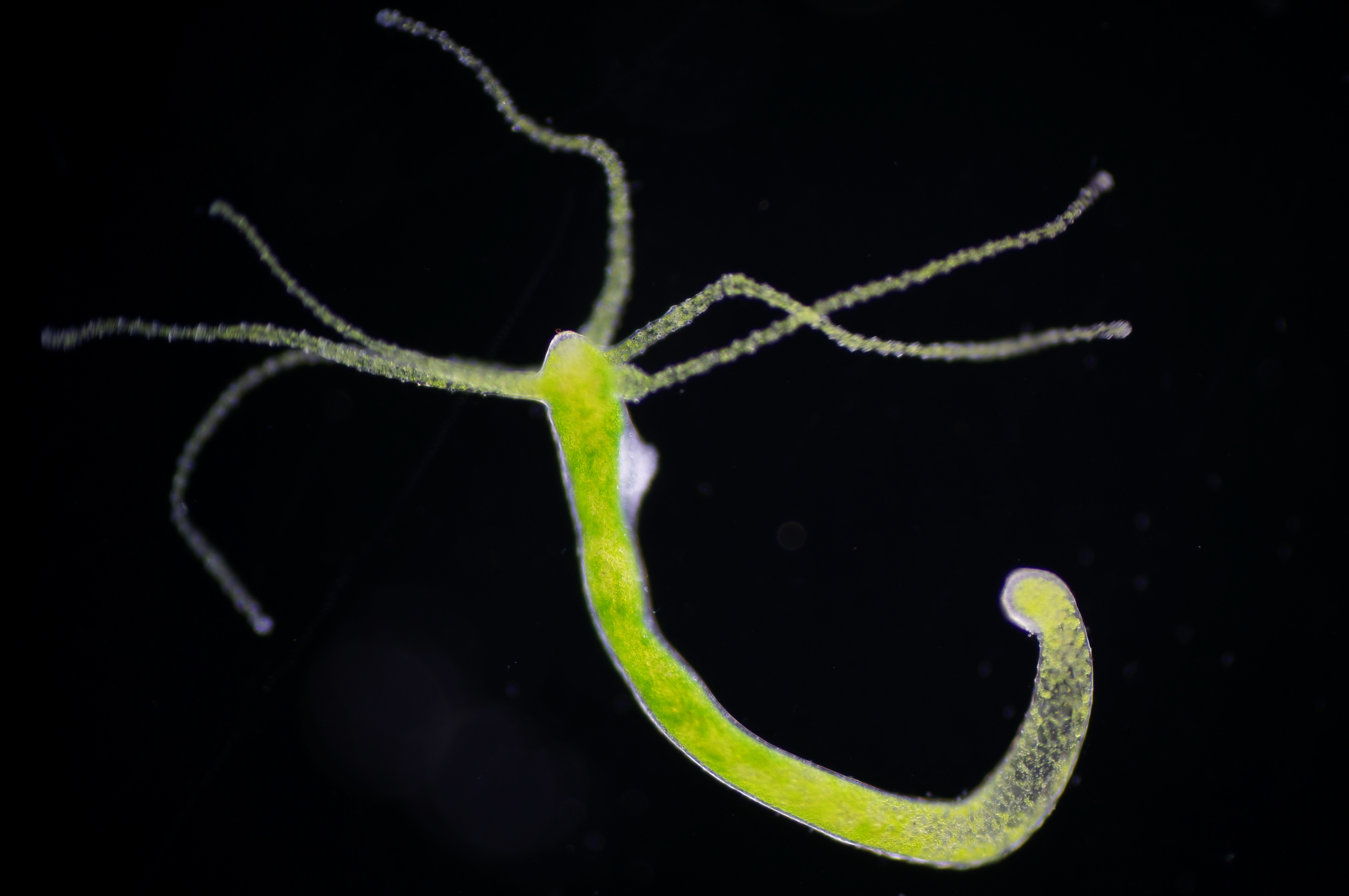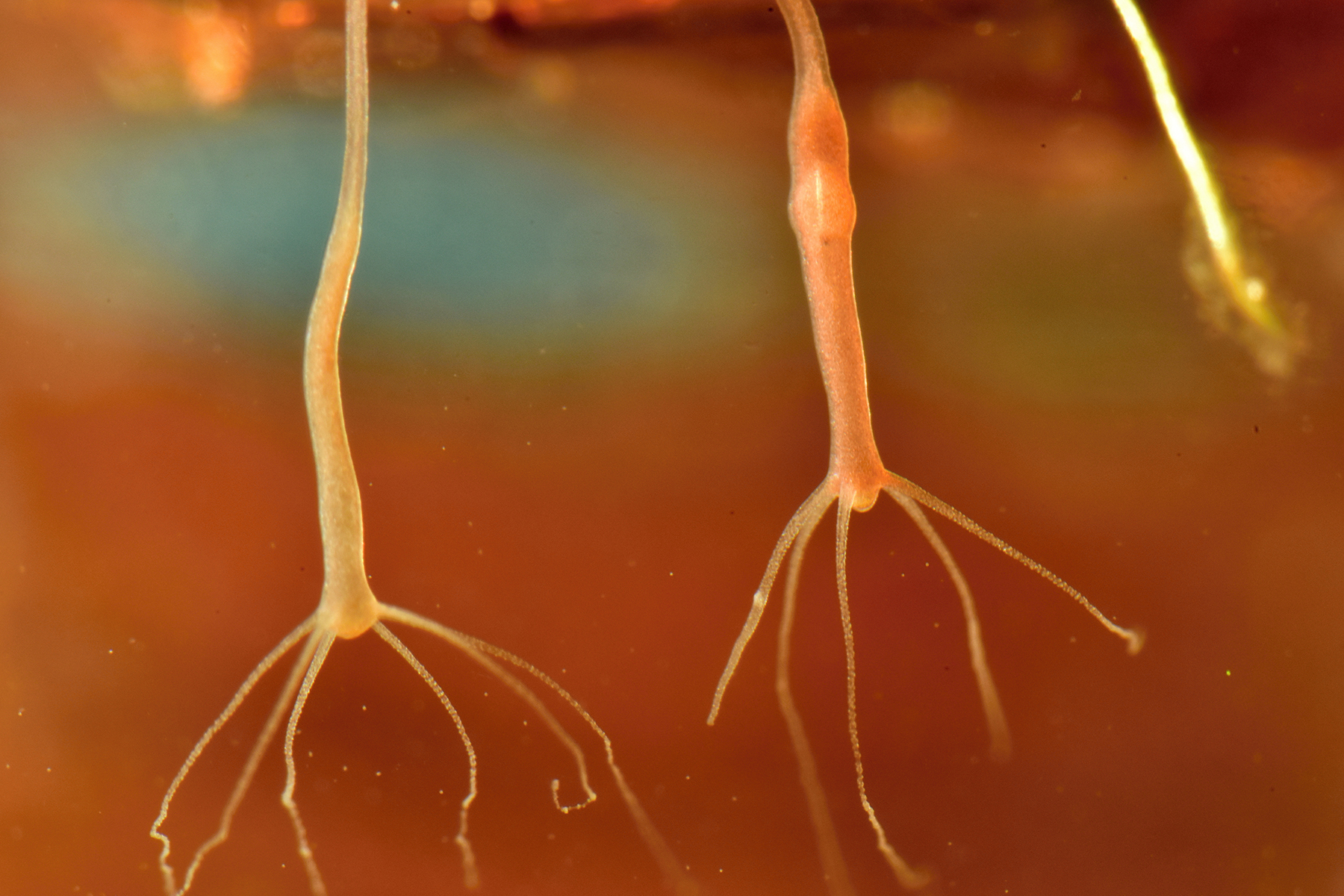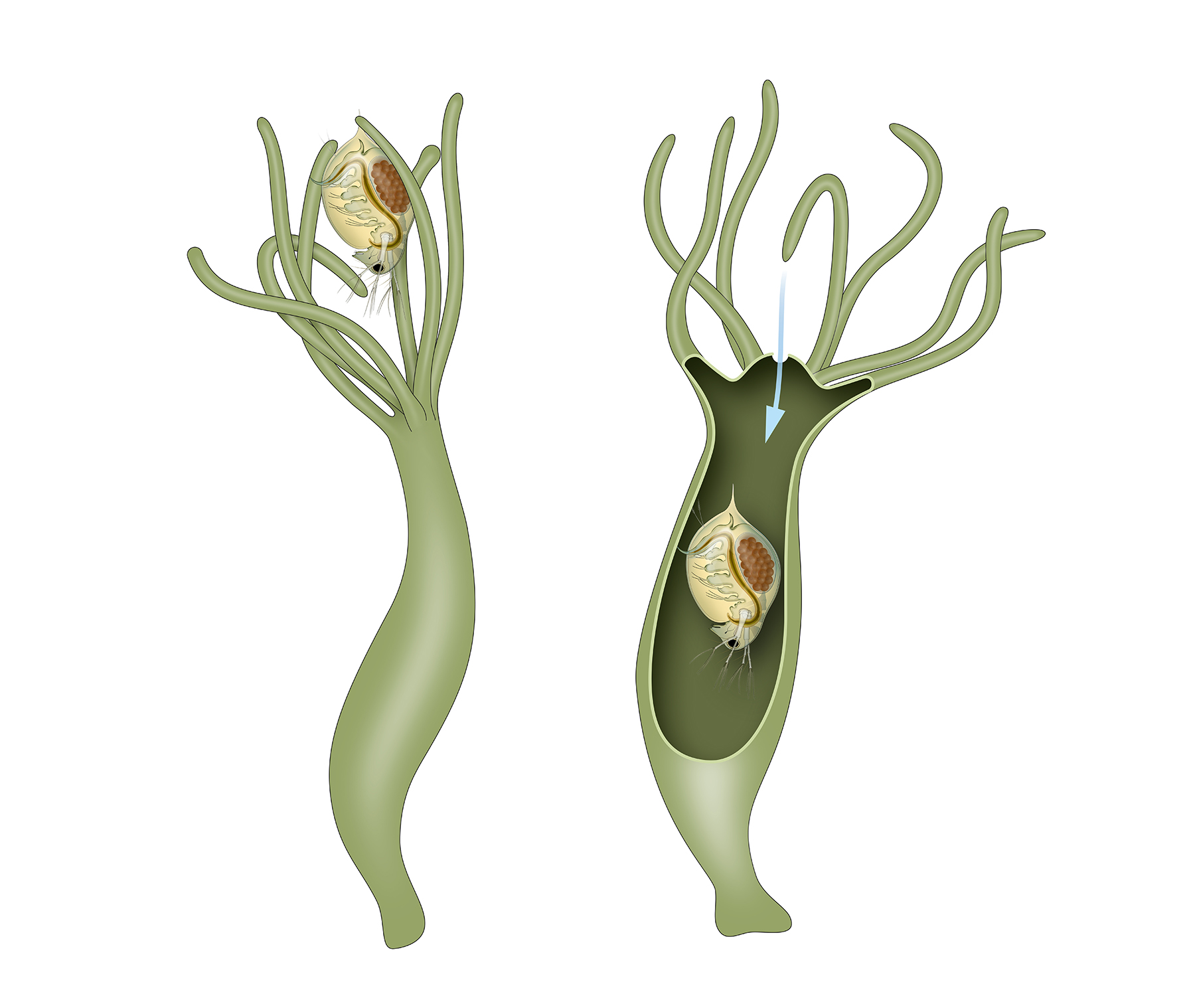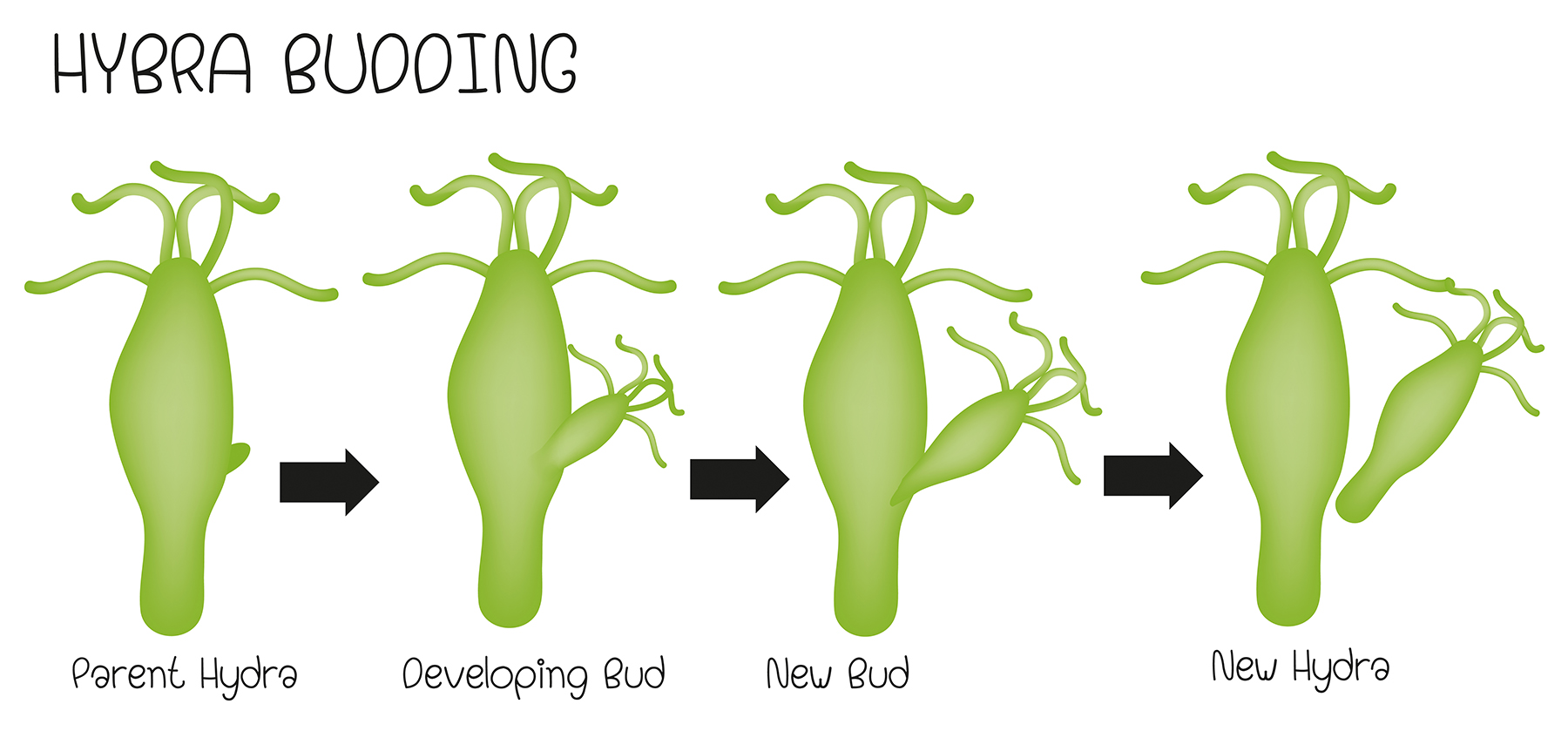Hydra or freshwater polyps - small cnidarians in the aquarium
Table of contents
- Hydra in shrimp aquarium
- Structure of a Hydra
- How big do hydras grow?
- Special case green hydras
- Where to find Hydras in the aquarium?
- Hydra and the water quality
- What does a Hydra eat, and how does it catch its food?
- How do hydras move around?
- Are hydras dangerous for shrimps?
- How do hydras reproduce?
- How do you get hydras into the aquarium?
- What was that about old age death?
- How to get rid of hydras from the aquarium?
Hydra in the shrimp aquarium
In the aquarium Hydra, also called freshwater polyp, is a frequent guest. The small creatures often sit on the glass or on plants or on the aquarium decoration, and very rarely also sometimes on a snail shell or on the shell of shrimps or crayfish. They look like an umbrella without fabric, sometimes they are described as looking like corals.
In fresh water there are no corals, but like them hydras are also cnidarians. The White Hydra(Hydra vulgaris) - which, despite its name, is usually more light brown to beige in color - and the Green Hydra(Chlorohydra viridis, also sometimes called Hydra viridissima or Hydra vir idis) are most commonly found in our aquariums.
Hydras fascinate many people because they look unusual, have a very special life strategy and because they do not know old age death. The regeneration ability of hydras is legendary.
Structure of a Hydra
Strictly speaking, a hydra has several body parts: an adhesive disk at the bottom of the actual body, which ends at the top with an amazingly stretchable mouth opening. Inside the body are the organs - the digestive tract and the sexual organs.
Around the mouth opening sit 5-12 thin tentacles or tentacles, which sit at the top of the rather thicker body and which spread out in a radiating pattern. On them sit close to each other nettle capsules - per tentacle sit here up to 3500 of them. They can be seen with a good magnifying glass as tiny dots sitting somewhat raised on the tentacles. Under the microscope you can see them clearly.
Their body is surrounded by a tubular muscle. If the hydra is disturbed, it can contract into a small lump.

How big do hydras grow?
The body of a hydra is not that big, in the aquarium it grows between 2 and a maximum of 10 mm long - but it is difficult to measure because the hydra can contract and extend it. If you measure the body and the tentacles hanging from it, hydras come to a total length of 1-3 centimeters. Hydras in the aquarium usually remain relatively small. The prey they can handle is correspondingly small.
Special case green hydras
The freshwater polyps normally found in the aquarium are light brown to beige in color. The Green Hydra is an exception, it is pale green to intense green. This coloration comes from the fact that they have incorporated Chlorella algae, with which they live in symbiosis. They perform photosynthesis and produce sugar, of which the Green Hydra also gets some. In this way, the algae contribute to the Hydra's energy supply. In return, the Hydra protects them.
The Green Hydra is difficult to starve out because it does not rely exclusively on prey to survive. Thus, it is still found in waters where there is not as much microfauna. The Green Hydra only grows to a total length of 10-15 mm (measured with tentacles) and has very short tentacles. The prey of the Green Hydra has to be much smaller again, with normal sized newly hatched baby shrimp it is already clearly overtaxed.
Where can you find Hydras in the aquarium?
Freshwater polyps like to sit on hard substrates, on aquarium decorations, on the aquarium glass. They like to sit in places with a slight current that drives their prey to them.
Hydra and the water quality
In aquatic management, hydras are used as indicator animals; they are found only in very clean, uncontaminated water. The saprobity index of the Green Hydra is 1.3, which stands for water quality 1 (unpolluted to very slightly polluted).

What does a Hydra eat, and how does it catch its food?
Freshwater polyps live predatorily, eating tiny organisms in the water: worms, small crustaceans such as cyclops or ostracods and their offspring, young water fleas, tiny insect larvae, small water mites, and generally small zooplankton. When a large specimen of a Hydra encounters a newly hatched juvenile shrimp, the juvenile shrimp becomes prey. Larger crustaceans, such as water fleas, are usually already unmanaged.
Hydras cannot actively hunt because they are stuck on the substrate with their suction cup. They depend on the prey swimming into their tentacles or being carried there by the current.
If a tentacle is touched, the hydra fires venom from the cnidocysts and the prey gets stuck. The venom paralyzes or kills the animal. In response to the nettling, the prey produces the peptide gluthathione as a defensive response. Hydra has sensory cells that detect this substance. If increased glutathione is detected, the tentacles move toward the mouth opening and the prey is swallowed and digested. Hydras can go a long time without replenishing food after feeding.

How do hydras move around?
A hydra is not a very mobile animal, but it is somewhat mobile. What it can't do: Jump at her prey or run after it. However, if it no longer likes the conditions at its stand, it can change its location.
To do this, it detaches its adhesive disk from the substrate. Then the hydra bends in a U-shape and goes into a headstand. It then moves its adhesive foot to the other side until it reaches the ground, where it holds on to the adhesive disk and stands up again - so in principle the Hydra does a very slow somersault. This is how it covers its distance millimeter by millimeter. For 2 cm it can take up to 24 hours - so Hydras are really not the fastest aquarium inhabitants.
In order to reach the top, the Hydra forms a gas bubble under its adhesive disc, which it can use to carry itself upwards.
Are hydras dangerous for shrimps?
Hydras are often portrayed as dangerous shrimp-eating monsters, but they can hardly eat the aquarium empty. Only very newly hatched shrimp or the young shrimp of particularly small species like Blue Bee are actually endangered.
It is a different matter if you feed plenty of fine live food like Artemia or if you make the microfauna in the aquarium multiply accordingly by feeding too much - then the hydras find plenty of food and can form whole carpets. If the shrimp can no longer sit down without becoming entangled by the cnidoblasts in the tentacles of the hydras, this can severely stress them and in the long run also make them ill.
And what about in an aquarium with fish?
Fish cannot be harmed by the small freshwater polyps, but they can become entangled if they touch them. Very small fish larvae can be preyed upon by large hydras. In nursery aquariums where a lot of Artemia is fed, hydras can proliferate. In community aquariums, however, hydras are fairly unproblematic.
How do freshwater polyps reproduce?
Hydras can reproduce asexually by budding and sexually by eggs. In asexual reproduction, a sprout forms on the side of the hydra. Sometimes one or even more shoots are seen sitting on the side of a hydra - first as a lump, later as a miniature hydra. When sufficiently developed, the shoots lace off and go in search of a nice place to live on their own.
In unfavorable conditions, the hydra mate and form white round eggs - for example, when food becomes scarce or when the water body threatens to dry up. These permanent eggs, also called cysts, are resistant to frost, heat and drought. The permanent eggs of the hydra are tiny and very light. If the biotope dries out, they are carried along by the wind and thus also enter our aquariums.

How to get hydras into the aquarium?
In addition to the cysts, which are part of the natural dust content of the air and can be easily carried into the aquarium by the air, they can also be brought in with plants or decorations from an aquarium in which hydras already live. Deco collected in the field from bodies of water with a suitably high water quality can bring in hydras, as can pond food. The permanent eggs of freshwater polyps are frost resistant and can therefore also enter the aquarium with frozen food.
What was that about old age death?
Hydras can constantly renew their tissue because it contains a high number of stem cells. Within five days the complete freshwater polyp is, so to speak, once revised and brand new. Hydras can therefore never die due to old age. However, they are not immune to catastrophes - heat, drought, poisoning, starvation (except for the Green Hydra, which has elegantly solved this problem through its symbiosis with Chlorella algae) ... this and more will kill a Hydra.
Regeneration from smallest parts
Even if parts are separated, on the one hand these parts regenerate on the animal, on the other hand a completely new Hydra grows from the separated part. One two-hundredth of a Hydra is already enough to completely regrow a new animal. So crushing is only a viable way if you want to have as many hydras as possible as quickly as possible.
Wiping or scraping off Hydra in the aquarium is therefore also no way to get rid of hydras - usually the sucker foot tears off completely or partially and regenerates into a new Hydra.
If you cut a hydra apart, the two parts may seek each other out, reunite, and grow together again to form a whole animal - or they may become two new hydras.
How to get rid of hydras from the aquarium?
Often hydras in the aquarium are only a temporary "problem", and they disappear by themselves. With larger accumulations one should think about the amount of food - hydras do not eat food remains, but small worms and smallest crustaceans such as mussel crustaceans or Cyclops do - and these multiply then strongly, so that the hydras find then nevertheless much food and reproduce likewise strongly.
Containment through sparing feeding with good food
By feeding appropriately with high quality food, you keep the accompanying fauna short and thus also the freshwater polyps in check. This type of feeding also has a positive effect on water quality in the aquarium.
Unfortunately, the starvation thing does not work so well with green hydras, because they are well supplied by their symbiotic algae. In the aquarium hobby, however, very few aquarists report massive infestations of green hydras - it can be assumed that the water in most tanks is simply not clean enough, and that the green hydras therefore do not establish themselves permanently.
Containment by predators
Hydras also have predators: guppies and labyrinth fish are said to eat hydras, and yoda snails (actually these snails are called pointed mud snails) have been observed eating hydras by many aquarists. However, they do not eradicate the entire population of freshwater polyps, but they do keep the population short and the number of hydras under control.
Containment through a salt treatment
Hydras are sensitive to a whole range of substances, such as simple table salt. For a salt treatment, 3-5 g of sodium chloride per liter of aquarium water is sufficient. Please use only pure table salt, no iodized salt or salt mixed with fluorine. Salt with a trickling agent or separating agent is also not optimal in the aquarium.
Flushing salt, on the other hand, is considered to be very pure table salt and has often been used with great success against hydras. About 3-5 days after salting all hydras should be dead. Beware, some scaleless fish like catfish and also some aquatic plants do not tolerate salt in the water well!
Because the permanent eggs or cysts of the hydras are not affected by the salt, re-treat after two weeks.
Containment by lowering pH
Hydras do not tolerate a low pH - but neither does the aquarium stock as a rule. If you have only a few animals in the aquarium that can easily be moved during treatment, lowering the pH with citric acid or CO2 is also a good option to get rid of the hydras.
Containment through targeted misting
Instead of salting up the entire aquarium, you can use a syringe to spray a more concentrated salt solution directly on the hydras in the aquarium. This fogging also works with Easy Carbo, with pomegranate broth or with lemon juice. Scalding with hot water from a syringe also works very well.
Flubenol and Panacur
Worming agents such as Flubenol and Panacur are also deadly to hydras, but there are so many other ways to target hydras in the aquarium that it would be shooting a cannon at a sparrow to use these prescription remedies against freshwater polyps in the aquarium. In addition, these agents are also lethally toxic to snails in the aquarium, and they deposit in the substrate where they can continue to cause problems for months. All in all, Flubenol and Panacur should only be used to control hydras in extreme emergencies!
Already 0.25 mg of the active ingredient of Panacur, Fenbendazol, or 0.1 mg of the active ingredient of Flubenol, Flubendazol, per liter of aquarium water is sufficient to control hydras in the aquarium. After two weeks, re-treatment should be carried out because any eggs laid in the aquarium will not be affected by this.

5€ Gutschein nervt
Ich finde euren Blog super, allerdings kann ich ihn auf dem Handy bloß sehr schwer lesen, da dieser 5€ Gutschein durch den newsletter im Weg ist... ich kann den auch nicht weg klicken oder einfach meine email eingeben, da ich den newsletter bereits abonniert habe ansonsten immer weiter so,
Lg, Max!
Grüne Hydra im Aquarium
Hallo. Leider scheint mein Wasser im Aquarium sehr gut zu sein.... Ich habe seit Wochen einen Befall der grünen Hydra. Und der scheint es richtig gut bei mir zu gefallen. Ich habe mir aber nun eine co2 Anlage zugelegt um meinen Algen entgegen zu wirken... Und hoffe damit auch gleichzeitig die hydren einzudämmen... Von welcher Firma ist easy carbo? Kann man das trotz co2 Anlage benutzen?
Frage zur Übertragung von Cysten
Vielen Dank für den informativen Artikel, gleichwohl spannend wie strukturiert. Doch zur Behauptung dass Cysten der Hydren als Teil des natürlichen Staubanteils der Luft übertragen werden würde mich sehr interessieren ob es hierfür einen Beleg oder weiterführende Literatur gibt.